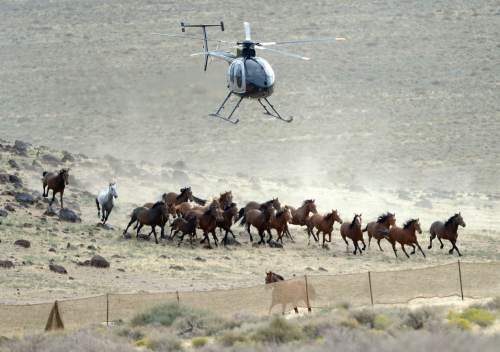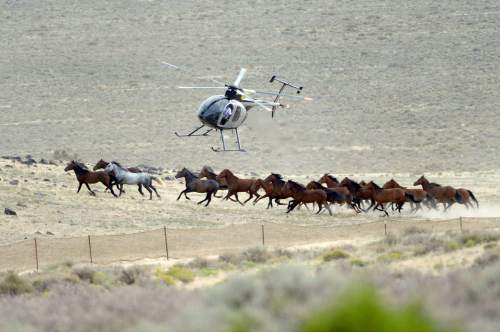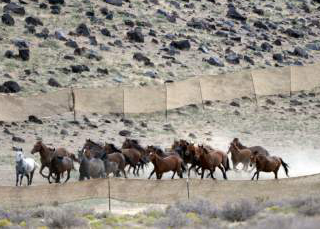This is an archived article that was published on sltrib.com in 2016, and information in the article may be outdated. It is provided only for personal research purposes and may not be reprinted.
The Bureau of Land Management has settled a lawsuit brought by Utah trust-lands officials over wild horse management, conceding greater influence to the state in deciding whether to remove "excess" horses from herds that roam over state trust lands in the midst of public lands.
BLM also promised to make "reasonable" efforts to clear two tracts of horses every other year.
Last year, the Utah School and Institutional Trust Lands Administration, or SITLA, filed suit in U.S. District Court, alleging the BLM was failing in its duty to manage federally protected horses and burros, to the detriment of the state lands that are interspersed with the public lands administered by the BLM.
Some regard free-roaming mustangs, descendants of domestic horses that Spanish explorers released centuries ago, as icons of the West that symbolize a spirit of freedom. But ranchers and other rural Utahns regard them as an invasive exotic species that no longer belongs on the range, which should be used for grazing.
According to various lawsuits, non-native horses proliferate in the absence of predators and excessive numbers are depleting the range, displacing ranchers who hold grazing permits on public and state trust lands.
In a news release announcing the settlement last week, BLM vowed to do the things the agency, which manages 23 million acres in Utah, has long claimed it already does, namely collaborate with local stakeholders and protect resources.
The agreement "provides for a mutual commitment to work cooperatively to manage wild horses that have entered onto SITLA lands. The agencies will meet annually to identify priority removal areas, ensure environmental review, conduct aerial population surveys jointly and monitor rangeland resources and improvements."
So what's new?
"We have never [before] partnered up with the state of Utah to coordinate efforts to do that," said Gus Warr, who directs the BLM's wild horse program in Utah. He expects the BLM will authorize him to remove 50 horses a year in Utah, and under the new agreement, the state will help choose areas to receive priority attention.
The deal's provision are subject to appropriations from Congress.
The 1971 Wild Free-Roaming Horses and Burros Act prohibits SITLA and other state agencies from unilaterally removing wild horses from trust lands. This law recognizes that horses "contribute to the diversity of life forms within the nation and enrich the lives of the American people," and charges the BLM with managing these animals.
But ranchers and county commissioners have long complained the BLM allows horses free rein at the expense of grazing.
SITLA manages 3.4 million acres, most of them in checkerboard sections among seas of BLM lands, to raise revenue for Utah schools. Some 207,000 acres lie within Utah's 19 Herd Management Areas.
Tensions over wild horses focus on a consolidated block of SITLA land in Iron and Beaver counties known as Blawn Wash, which sits outside any designated horse management area. Since 2000, the BLM has removed 550 horses in four roundups from this herd, which soon repopulates. Most recently, in the summer of 2014, the feds pulled all 143 horses they encountered.
Some of the gathered animals are adopted out, but most join thousands of other formerly free-roaming horses spending their lives in captivity at enormous expense to U.S. taxpayers. Federal law prohibits the killing of wild horses except for humanitarian purposes.
Warr said aerial surveys indicate 75 to 100 horses continue to live on Blawn Wash. Under the agreement, BLM will remove up to 150 horses from Blawn and surrounding lands and up to 50 horses and burros affecting the McKay Flat grazing allotment in the Muddy Creek Herd Management Area in 2016. Both areas will be hit with repeat roundups every other year.
Horse advocacy groups, which had sought to intervene in the suit, were suspicious of the settlement.
"The goal here is to force BLM to do more removals. It's not fair to the horses and not fair to the American taxpayers. All this is going to do is further exacerbate the mismanagement of wild horses," said Deniz Bolbol of the American Wild Horse Preservation Campaign. "This is an agency that is hellbent on treating these horses like livestock."
The BLM's wild horse program is completing environmental reviews of two upcoming Utah operations, one to erect fencing in a remote stretch of West Desert highway where horses from the Sulphur herd tend to congregate. The other is a roundup for research targeting burros from the Sinbad herd in Emery County.
According to BLM data, there are about 4,600 wild horses in Utah, far in excess of what the agency pegs as the "appropriate management level" for Utah's 19 herds. Federal land managers have set Utah's management levels at between 974 and 1,786, a number horse advocates say is arbitrarily low.
Ironically, Muddy Creek, targeted for regular roundups in the San Rafael Swell, is home to the only Utah herd whose population doesn't exceed its target.
The SITLA settlement will allow ranchers' related lawsuit to move forward. The Western Rangeland Conservation Association is demanding the agency remove horses in herd management areas that exceed "appropriate management levels." The group alleges that lax management is allowing horse numbers to explode, and that these animals are consuming the forage and tearing up the ground.
Horse advocates are contesting the suit, saying that overgrazing by subsidized stockmen is the real culprit behind poor range conditions. Bolbol blasted the "appropriate management level" system that sets the target for the West's wild horse herds at 16,000.
"That is below the number of wild horses living on the land in 1971 when the law was passed and Congress found wild horses were fast disappearing," she said. "It's a complete fraud. It's one more cog to allow BLM and ranchers to work together to keep horse numbers unreasonably low."
Brian Maffly covers public lands for The Salt Lake Tribune. Maffly can be reached at bmaffly@sltrib.com or 801-257-8713.
Twitter: @brianmaffly











